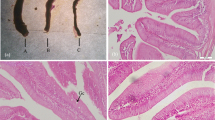Abstract
A 3×3 factorial experiment was conducted to determine the effects of water temperature (22 °C, 27°C and 32°C) and dietary carbohydrate (CBH) levels (15.47%, 29.15% and 41.00%) on growth, food consumption, feed efficiency, apparent digestibility coefficient and energy budget of juvenileLitopenaeus vannamei. The results showed that, at each dietaryCBH level, specific growth rate, food consumption and apparent digestibility coefficient generally increased, while feed efficiency decreased with increasing water temperatures. Specific growth rate and food consumption were the highest in the shrimps fed with diet of 29.15%CBH, closely followed by those with 15.47%CBH, and those with 41.00%CBH had the lowest value.
Similar content being viewed by others
References
Alava, V. R. and F. P. Pascual, 1987. Carbohydrate requirements ofP. monodon (Fabricius) juveniles.Aquaculture 61: 211–217.
Ali, S. A., 1982. Effect of carbohydrate (starch) level in purified diets on the growth ofP. indicus.Indian Journal of Fisheries 29: 201–208.
AOAC (Association of Official Analytical Chemists) 1995. Official methods of analysis of official analytical chemists international, 16th edn. Association of Official Analytical Chemists, Arlington, VA.
Cai, Y. X. and S. Z. Chen, 1995. The prawns and crayfishes introduced to China.Sinozoologia 12: 170–179.
Cui, Y. B., S. L. Chen and S. M. Wang, 1995. Effect of temperature on the energy budget of the grass carp,Ctenopharyngodon idellus Val.Oceanologia et Limnologia Sinica 26(2): 169–174. (in Chinese with English abstract)
Cuzon, G., A. Lawrence, G. Gaxiola, C. Rosas and J. Guillaume, 2004. Nutrition ofLitopenaeus vannamei reared in tanks or in ponds.Aquacuture 235: 513–551.
Dai, X. Q., Y. Xiao and J. Dong, 1998. Effects of temperature and salinity to energy budget ofLateolabrax japonicus.Journal of Shanghai Fisheries University 7(1): 1–7.
Dong, S. L., N. S. Du and W. Lal, 1994. Studies on the physio-ecology ofMacrobrachium nipponense II. Effect of temperature and body weight on energy budget.Oceanologia et Limnologia Sinica 25(3): 238–242. (in Chinese with English abstract)
Hu, A. S., 1958. Glucose metabolism in the crab,Hemigrapsus mudus. Archs Biochem.Biophys. 75: 387–395.
Jiang, D. H., H. N. William and H. Gong, 2000. Effects of temperature and salinity on nitrogenous excretion byLitopenaeus vannamei juveniles.J. Exp. Mar. Biol. Ecol. 253: 193–209.
Levine, D. M. and S. D. Sulkin, 1979. Partitioning and utilization of energy during the larval development of the xanthid crab,Rithropanopeus harrisii (Gould).J. Exp. Mar. Biol. Ecol. 40: 247–257.
Omondi, J. G. and J. R. Stark, 1995. Some digestive carbohydrases from the midgut gland ofPenaeus indicus andPenaeus vannamei (Decapoda: Penaeidae).Aquaculture 134: 121–135.
Ponce-Palafox, J., C. A. Martinez-Palacios and L. G. Ross, 1997. The effects of salinity and temperature on the growth and survival rates of juvenile white shrimp,Penaeus vannamei, Boone, 1931.Aquaculture 157: 107–115.
Rosas, C., G. Cuzon, G. Taboada, C. Pascual, G. Gaxiola, A. C. van Wormhoudt, 2001. Effect of dietary protein and energy levels on growth, oxygen consumption, haemolymph and digestive gland carbohydrates, nitrogen excretion and osmotic pressure ofLitopenaeus vannamei (Boone) andL. setiferus (Linne) juveniles (Crustacca, Decapoda; Penaeidae).Aquaculture Research 32(7): 531–547.
Villarreal, H., P. Hinojosa and J. Naranjo, 1994. Effect of temperature and salinity on the oxygen consumption of laboratory producedPenaeus vannamei postlarvae. Comp.Biochem. Physiol. 108A: 331–336.
Wyban, J., W. A. Walsh and D. M. Godin, 1995. Temperature effects on growth, feeding rate and feed conversion of the Pacific white shrimp (Penaeus vannamei).Aquaculture 138(1–4): 267–279.
Zhang, S., S. L. Dong and F. Wang, 1998. Studies on the bioenergetics ofPenaeus chinensis, II. Effects of temperature and body weight on energy budget.Journal of Ocean University of Qingdao 28(2): 228–232.
Author information
Authors and Affiliations
Corresponding author
Additional information
Supported by the Chinese National Agricultural Development Project (No. K2002-15) and the Science Research Council of Shandong Province. China (No. 041656).
Rights and permissions
About this article
Cite this article
Xingqiang, W., Shen, M. & Shuanglin, D. Effects of water temperature and dietary carbohydrate levels on growth and energy budget of juvenileLitopenaeus vannamei . Chin. J. Ocean. Limnol. 24, 318–324 (2006). https://doi.org/10.1007/PL00020779
Received:
Accepted:
Issue Date:
DOI: https://doi.org/10.1007/PL00020779




